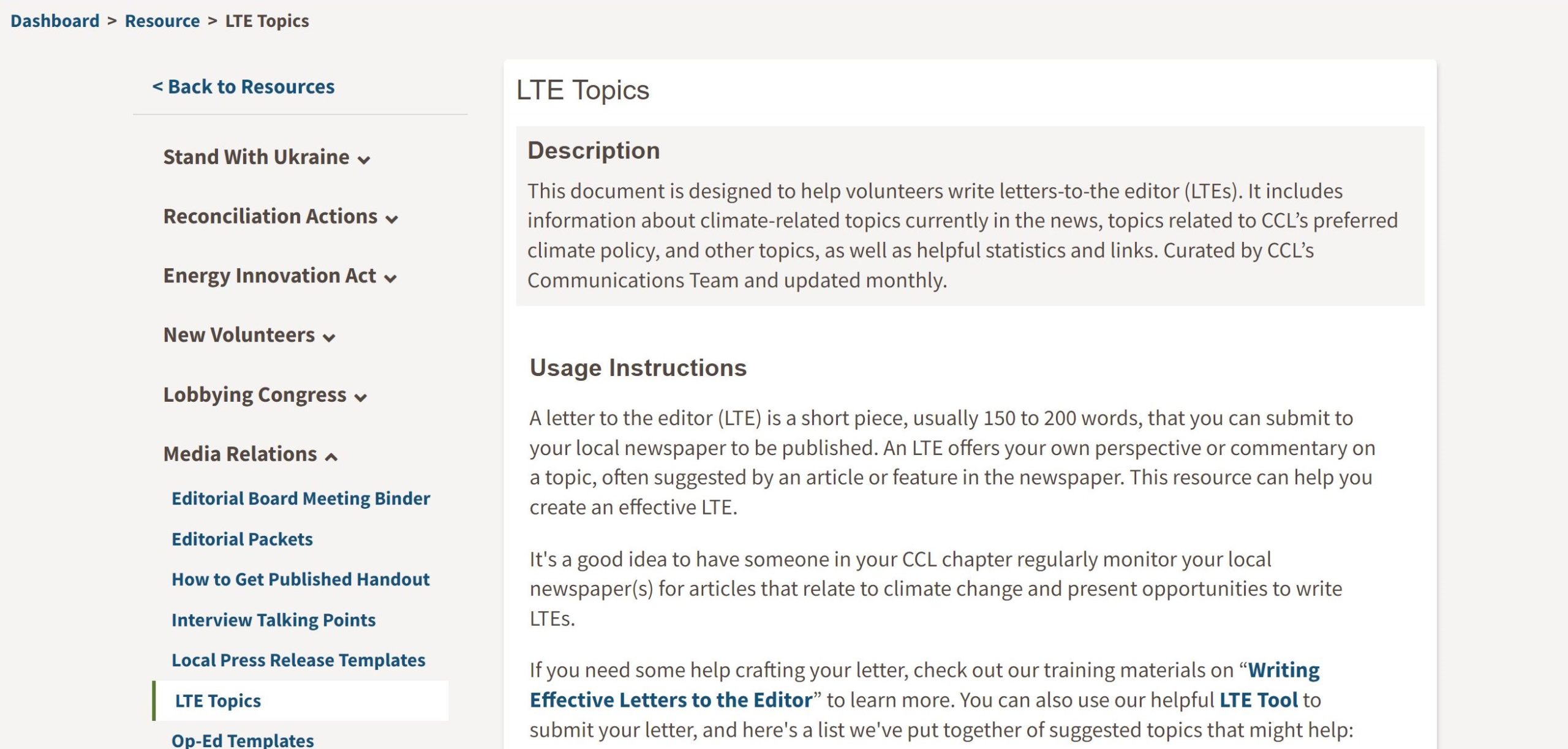By Berit Thorson
Learn how to write a letter to the editor with our guide. To first define letters to the editor (LTEs): they are a highly effective way CCLers can let members of Congress know constituents in their district care about climate action. LTEs are essentially a chance for community members to have their say in print in response to something published recently in a newspaper or something else timely or newsworthy. People write LTEs to support or oppose a stance, point out the impact of a story, or call on their members of Congress to take action.
Like phone calls, writing a letter to the editor of a local newspaper is an important way to voice concerns and priorities to your community and members of Congress. The staffers of our elected officials monitor the local newspapers to get a sense of what issues are of concern in their districts or states. If writers mention members of Congress by name in LTEs about climate action, the letter is likely to end up on their desks.
Watch the video on How to Write a Letter to the Editor:
Writing LTEs about climate change and carbon pricing sends a clear message to your members of Congress that they should consider supporting such policy. But how do you actually go about writing them?
Luckily, CCL has some wonderful resources to help you. In addition to this blog, you can check out this six-minute training on How To Write Effective Letters to the Editor, put together by Charlotte Ward, CCL’s State and Local Media Coordinator.
The letter-writing process is fairly simple. Here is an overview:
- Pick a topic. Look through your newspaper to see if there are recent news stories about climate change, extreme weather, or issues that relate to the need to transition to clean energy and cut emissions.
- Write your letter. Plan to write 150-250 words on a timely topic that relates to climate change. Be sure to include your name, address, and phone number so they can verify that you are a real person before they publish your LTE.
- Submit your letter. Check out the submission page of your local paper and follow the instructions, paying close attention to word count and other guidelines. CCL has a handy LTE tool which identifies local newspapers via your zip code! You can submit your letter through that tool or via the newspaper’s website.
- Monitor the paper. Editors will not necessarily tell you if your LTE was accepted and published, so keep an eye out for your piece.
- Share your success! When you get a letter published, tell your CCL district liaison so they can forward your letter to your members of Congress. You can share your letter on social media. You could also thank the editor who published the piece. Don’t forget to log your LTE success in CCL’s Action Tracker!
You can find plenty of support from other CCLers as you start the process of writing LTEs. CCL’s Writers Circle Action Team on CCL Community contains many LTE-writing tips and examples of great letters to the editor, as well as peer support from other CCLers. On the second Tuesday of each month, Charlotte hosts a virtual LTE writing party open to all who are interested.
Just like calling Congress, writing something that will be published for others to read may be outside of your comfort zone, but your confidence will build quickly. Laura Reynolds, LTE team lead for CCL’s Flathead Valley Chapter in Montana, says, “With practice, [LTEs] get less daunting and more empowering.” She expands, saying that although “the short format writing is a new skill for many of us, I think it improves all our other communications.” Laura recommends that people keep their letter focused and simple, and make their words count, reminding us that to write a successful LTE, “You don’t need to be a writing diva.”
“Stay in touch with, and informed by, organizations that are up-to-date on government actions that should be promoted or opposed,” Andrew Hartley, the Monthly Calling Campaign coordinator for the NY-27 Congressional District, adds. He continues, saying, “Work in small teams to blitz [the] media on a given topic. If a media outlet is barraged with letters conveying the same message, it will realize the message is important to readers.”
Paula Danz, the Print Media team lead for CCL’s Silicon Valley North Chapter, also has some advice for new LTE writers. She says, “Some of us may be more interested than others in any given article or LTE opportunity. Let your passion be your guide. If you don’t feel inspired to write about something, that’s okay; there will be plenty of other opportunities. Feeling passionate about an article will most likely create a better LTE outcome.” She also wants to emphasize that if your letter is not published, “Try not to get discouraged. There is a lot of competition out there, and a lot depends on what else is happening in the news at the time.”
“Most importantly,” Paula says, “have fun with it!”
If you’re not sure where to begin with picking a topic for your letter, CCL’s Communications Team updates a list of timely LTE topics on a weekly basis. These range from the latest IPCC report or the relationship between inflation and climate change to the necessary transition to clean energy and updates about CCL’s preferred climate policy. Choose a topic that is personal to you, has relevance to your community, or responds to a recently published article in your local newspaper.
Once you have decided on a topic, start writing! CCL recommends following this formula for LTE success:
- Reference something in the news or a specific part of a news story from your local paper. Mentioning a story by name is often helpful.
- Transition into how that news relates to climate change. State the problem that needs to be solved. Try to avoid raising “hot button” issues and tones of climate doom.
- Identify a solution. For example, putting a price on pollution will lower emissions with the speed needed to avoid the worst impacts of climate change.
- Present a call to action. Urge members of Congress to support carbon pricing, cosponsor CCL’s preferred legislation or vote in favor of it.
- Close the circle. Circle back to the beginning of the letter and what it is you started writing about.
As you plan your letter, remember CCL’s values of relationships and appreciation. CCL’s State & Local Media Coordinator, Charlotte Ward, says, “Part of the reason we are able to meet regularly with members of Congress from either side of the aisle is because we are respectful, appreciative, and work hard to listen and find common ground.
“When we write letters to the editor that describe the climate action that is needed but express it alongside gratitude for the work of our elected officials, it is definitely noted.
“We also encourage letter writers to be optimistic. As more readers make the connection between heat-trapping carbon emissions and incidences of extreme weather, drought, wildfires, and record heat, our letters can help to give them hope that action is the antidote to despair.”
Now you know the basics of writing LTEs! We are excited to support your writing journey, read the letters you publish, and celebrate your accomplishments with you. Remember that you have a community here to support and encourage you.
If you are looking for other ways to take action, make sure to join CCL and participate in your local chapter.
TAKE ACTION NOW!
Use our online tools to reach your Representative directly:
Email or call your Representative
How to Write a Letter to Congress
Berit Thorson is the CCL Spring 2022 Communications Intern. As an outdoors enthusiast, she is passionate about protecting nature and people from the impacts of climate change, and is excited to be working with CCL toward these goals.







